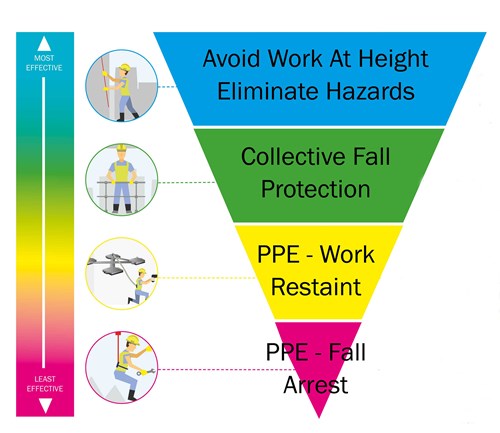
You are visiting the India Kee Safety website from United States. Would you like to go to the United States site?

The BS 13700 standard, which was published in July 2022, provides long-awaited guidance for the design, performance, testing, and inspection of permanent counterweighted roof guardrail systems. The standard provides clarity around the design and addresses the concerns many consultants faced when specifying rooftop guardrails.
However, before we explain what BS 13700 is about, and what it means for the installation of permanent roof guardrails, it’s important to understand why these systems are specified and why the new standard needed to be introduced.
Whenever we recommend a rooftop safety solution to our customers, we always follow a simple 4 stage hierarchy of control to recommend the most appropriate form of fall protection.

If the hazard cannot be eliminated by designing out the danger or through changing working practices, then the preferred option is always to use collective measures such as guardrails that protect everyone on the roof.
Simple really; if you want to protect people working on or accessing your roof, you should install a rooftop guardrail. But when you start looking at the different types of guardrails and what standards they need to conform to, the decision is not as straightforward as you might assume.
When deciding on which guardrail system to specify for the roof, you need to think about what the guardrail is there for. If you want the guardrail to be taken down once work is completed, then you will probably just need a temporary system, or possibly a folding one, but if you want to protect people working on your rooftop, then you will need a permanent solution, as access to the roof will be required several times a year.
Many permanent guardrails are fixed directly into the roof structure, and while this will provide suitable protection, these systems do have their drawbacks. For example, drilling holes into the roof to fix the system could void your roof warranty or cause costly water damage.
Permanent freestanding guardrails such as Kee Guard are the best option, as they are based on a simple cantilevered design that provides unrivalled strength, stability, and safety, and does not require the roof membrane to be penetrated during installation.
A freestanding guardrail system has the additional benefit of being quick and easy to install making it ideal for retrofitting as it avoids any business downtime or disruption to the building’s occupants or workforce.

Once the decision has been made as to which type of permanent roof guardrail should be specified, fixed or freestanding, the next decision is which standards should it comply to. It is always preferable to have standards to work to and for most fall protection systems, this can be relatively simple. However, when it came to permanent guardrails there was a lot of confusion, especially as existing standards were open to individual interpretation.
Roof edge protection was typically designed to comply with one of the following standards:
However, it was never clear which standard should be followed. For example, EN 13374 relates to temporary edge protection and does not specify the correct height of 1100mm for permanent guardrails. In addition, the stated wind loading requirements only apply to certain locations, which caused problems when specifying the system outside of the UK.
There was also the critical question of which standard was applicable to a system that was not physically connected to the building, in other words, the increasingly popular permanent counterweighted edge protection.
This new standard has been written specifically for manufactured permanent counterweighted guardrail systems that are not fixed directly to the roof’s structure, such as the KeeGuard system, and provides clear best practice guidance for those designing, testing, maintaining and inspecting these types of systems.
As a manufacturer of freestanding, counterweighted edge protection systems, Kee Safety naturally ensures that our product ranges comply with BS 13700 and all other relevant global standards and legislation, but what does the new standard mean to specifiers, installers, and the building owner?
If a permanent freestanding guardrail system was installed prior to July 2021, it is the responsibility of the building owner, premises, or health & safety manager to have the system inspected and retrospective wind calculations carried out to verify that the original design complies with the new standard.
The introduction of BS 13700 has gone a long way in clearing up the confusion surrounding compliance to recognised international standards. This is the first time clear and concise best practice requirements for permanent counterweighted guardrail systems have been provided.
Evidence must now be provided on the design of the system, wind calculations, and inspection regimes to demonstrate that the system has been designed, installed, inspected, and maintained to the highest standards.
As you can see, the specification of a guardrail system can be complex which is why you should always seek the assistance of professional and competent companies. If you need help with your project or would like further information on BS 13700 to enable you to comply with the standard, please get in touch with us.
The BS 13700 standard was written specifically for manufactured permanent counterweighted guardrail systems that are not fixed directly to the roof’s structure. The standard provides clear best practice guidance for those designing, testing, maintaining, and inspecting these types of systems.